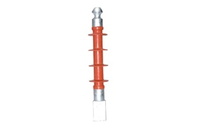Lightning Arrestor Resistors
Specifications
The lightning resistor for home is the core part of the lightning resistor. It uses zinc oxide as the main component, adding a small amount of bismuth oxide, cobalt oxide, chromium oxide, manganese
carbonate, antimony oxide and other trace additives, and is sintered at high temperature. The microstructure of thunder resistors is mainly composed of zinc oxide grains, grain boundary layer and
spinel phase.
Its conduction mechanism is generally believed that zinc oxide grains have good electrical conductivity, and the voltage applied to zinc oxide grains is almost all applied to the high-resistance
grain boundary layer, and the nonlinearity of the resistor sheet mainly comes from the grain boundary layer ( Bismuth oxide is the main component), and the spinel phase is scattered in the grain
boundary layer. It is a composite oxide composed of zinc oxide and bismuth oxide. Its function is to inhibit the growth of zinc oxide grains, so that the resistor has a more Excellent nonlinear
characteristics.
Manufacturing Process of Lightning Arrestor Resistors
The manufacturing process of resistors is a very important aspect to ensure the performance of resistors. In commonly used formulas, additives only account for about 5% to 10% of the total weight.
To mix additives and Zn0 evenly, the particles of additives should be fine and organic. Composition and content are crucial to the uniformity of the mixed slurry, and the uniformity of the slurry
is one of the guarantee factors affecting the uniformity of the composition and structure of the porcelain body.
High-temperature sintering is a process of porcelain formation. Conditions such as sintering temperature and holding time determine the density of the porcelain body, the shape and size of grains,
and the distribution of additives in grains and grain boundaries. The sintering temperature of the resistance sheet is around 1200°C or even higher. The cooling process after molding is a
redistribution process of lattice defects, impurities, oxygen, etc., and it is also a process in which the crystal phase may undergo a phase change. Heat treatment is a process method to improve
performance stability, and other properties, such as nonlinear coefficient, leakage current, breakdown voltage, etc., are also closely related to heat treatment temperature and time.
Both ends of the resistor sheet must be prepared with electrodes with good contact performance and conductivity. Commonly used electrodes are aluminum-sprayed electrodes and silver-burned
electrodes. Of course, because the price of silver is much higher than that of aluminum, manufacturers now commonly use aluminum-sprayed electrodes. The side of the resistor sheet has good
insulation protection (generally called insulating glaze) to avoid surface discharge when overvoltage is applied, and can also isolate the intrusion of humid air to avoid adverse effects.
For more information about distribution line hardware, please feel free to contact us!
- Country: China (Mainland)
- Founded Year: 2023
- Address: No.10 Longxi Road, Nan cheng Street, Dongguan, Guangdong, China
- Contact: YF POWER POWER









